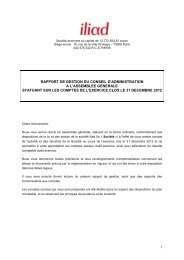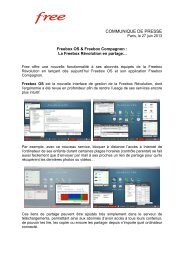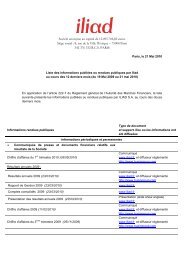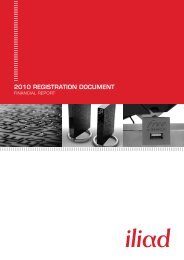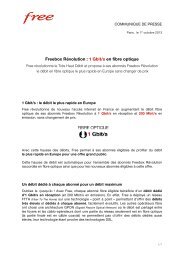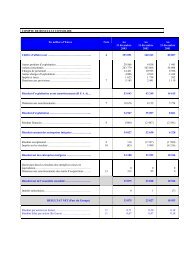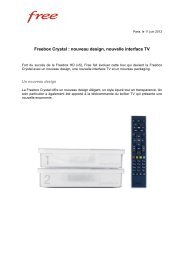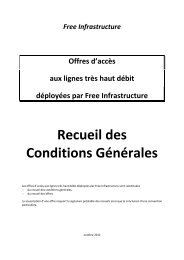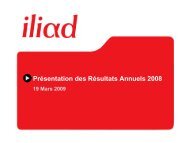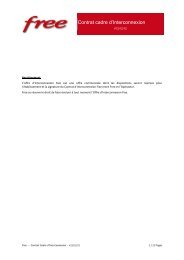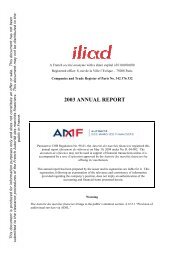REGISTRATION DOCUMENT AND FINANCIAL REPORT - Iliad
REGISTRATION DOCUMENT AND FINANCIAL REPORT - Iliad
REGISTRATION DOCUMENT AND FINANCIAL REPORT - Iliad
- TAGS
- registration
- iliad
- iliad.fr
You also want an ePaper? Increase the reach of your titles
YUMPU automatically turns print PDFs into web optimized ePapers that Google loves.
6. OVERVIEW OF THE GROUP’S BUSINESS<br />
6.1 PRINCIPAL ACTIVITIES<br />
Fibre optique<br />
de l’opérateur<br />
alternatif<br />
Site France Telecom<br />
CA<br />
Câble<br />
de renvoi<br />
répartiteur<br />
opérateurs<br />
URA<br />
DSLAM<br />
Espace dédié<br />
Schematic diagram of partial unbundling<br />
fréquences basses<br />
filtre<br />
Répartiteur<br />
d'abonnés<br />
fréquences hautes<br />
France Télécom<br />
Opérateur alternatif<br />
Nouveaux équipements<br />
ligne d'abonnés<br />
= boucle locale<br />
Abonnés<br />
filtre<br />
fréquences hautes<br />
fréquences basses<br />
(<br />
modem ADSL<br />
voix<br />
Internet<br />
DSLAM : Digital Subscriber's Line Access Multiplexer<br />
CA : Commutateur d'Abonnés<br />
URA : Unité de Raccordement d'Abonnés<br />
: point frontière de responsabilité<br />
In practice, an alternative operator needs to use an optical fiber network which terminates in France Télécom’s<br />
premises and install its own DSLAM equipment in co-location facilities or in dedicated spaces.<br />
Local loop unbundling completely frees an operator from dependence on France Télécom’s network. The<br />
recurring charges payable to France Télécom relate primarily to the rental of the copper pair, the splitter and the<br />
copper tie cable linking the subscriber’s modem to the operator’s DSLAM 13 .<br />
In the case of full unbundling, the alternative operator uses all the frequencies of a particular copper pair. In this<br />
case the user no longer pays telephone line rental to France Télécom and filters are no longer necessary.<br />
For the purposes of simplification, the following sections contain the abbreviations MSU (for the digital main<br />
switching unit) and LX (for the digital local exchange) in relation to interconnection and the term “France<br />
Télécom site” in relation to local loop unbundling.<br />
6.1.3.2 Development phases of the Group’s network<br />
6.1.3.2.1 Interconnection at the MSUs and all LXs in the Paris urban area<br />
The first development phase of the Group’s network, implemented between August 2000 and April 2001, was the<br />
interconnection at the digital main switching units (MSU) and all digital local exchanges (LX) in the Paris urban<br />
area for the collection of data traffic.<br />
Initially, the Group’s main objective was to interconnect its network to that of France Télécom in order to obtain<br />
a minimum level of national coverage. This required the Group to be connected to at least the 18 France Télécom<br />
MSUs covering all the regions of mainland France. The Group’s network at that time consisted of modem servers<br />
operated by Free and capable of meeting the needs of dial-up Internet subscribers.<br />
Between August 2000, the date of the first interconnection in Lille to the MSU for the northern region, and<br />
June 2001, the date of the last interconnection in Poitiers to the MSU for the central region, Free’s teams ordered<br />
E1 transmission capacity on France Télécom’s network which it interconnected directly to the Group’s network<br />
using optical fibers leased from a provider which had already installed the fiber network.<br />
13 See Sections 9.2.1.2 and 9.2.1.3 of this registration document for a description of the fixed and variable LLU charges.<br />
26 - <strong>Iliad</strong> – Registration Document 2007



